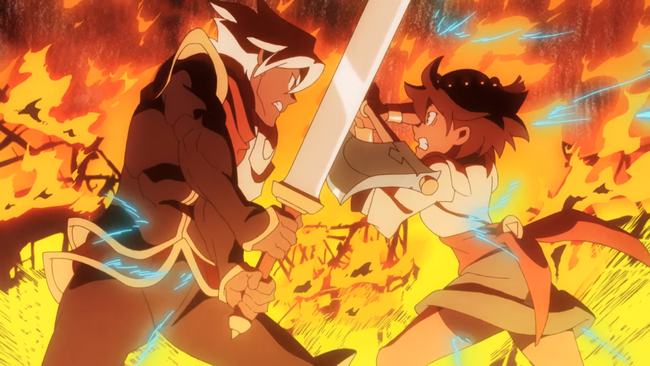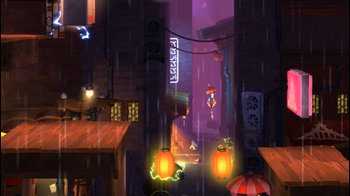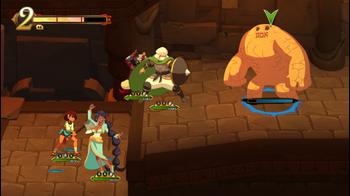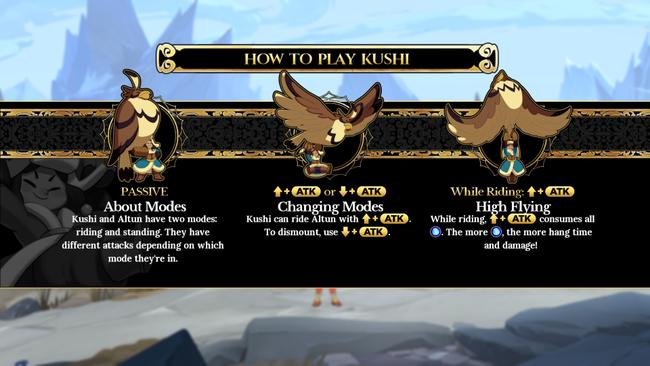
Indivisible Review
Think about the first party member you get in an RPG. Usually, it’s a childhood friend, a bodyguard, or a random stranger you just met by chance. In Indivisible, that person is the one who murdered your father.
With a successful Indiegogo campaign back in 2015, Indivisible has been cooking in the oven for a while. I think the long wait was worth it because Lab Zero’s newest project since Skullgirls is a fascinating RPG brimming with personality and heart. Indivisible is an astounding game that plays around with its Valkyrie Profile-rooted foundation in creative ways. It’s a fun ride that doesn’t overstay its welcome with several well-thought-out design decisions at its core.

Indivisible is as much of a 2D platformer as it is an RPG, like the PlayStation classic. Instead of leaning heavily against Valkyrie Profile, Indivisible diverges from it with several tools that the young, hot-headed Ajna obtains in her quest for vengeance. There are dozens of hidden areas to uncover and a lot of them aren’t accessible until she gains the right exploration ability in true Metroidvania fashion. Some of these include your typical mainstays in platformers like a higher jump or a ranged attack for hitting switches. Other skills are surprisingly a bit more involved, such as maintaining momentum after wall-jumps to bash down tougher doors. It was great to see that Indivisible’s platforming sections weren’t mere afterthoughts filled with basic, flat spaces; they’re well-tuned and cleverly integrated into the game’s environments. I definitely got some Celeste vibes throughout some of the more challenging sections and much like that game, the controls are responsive, tight, and easy to understand.
I can’t stress enough that the environmental design in Indivisible is exceptional. Each region is expansive, full of life, and most importantly, an absolute delight to explore. The places Ajna visits on her journey all have a distinct look and feel to them with their aesthetic inspirations derived from different cultures around the globe. Thus, Indivisible’s world pops out jubilantly. There’s a certain flow to their layouts that sparked my curiosity to explore every nook and cranny of them. It never crossed my mind on whether they were too big or too small; almost all of them felt just right.

Thanks to its Indiegogo campaign, Indivisible also has an incredible amount of uniquely designed NPCs that populate its remarkable world without feeling too out of place. It left me wishing that they were all recruitable; I wouldn’t even care if it didn’t make any sense because their designs are that good. Keen eyes will notice some cheeky fun cameos that snuck their way in as well.
There’s a certain art in properly making an RPG’s early game engaging. You may have heard the all-too-oft remark of “this game starts getting good after the first 20 hours” or “the real fun starts in post-game” and such. Luckily, Indivisible rises above this.
Ajna’s initial journey goes through several expected twists and turns, but it does an excellent job pacing itself. Indivisible’s opening hours don’t drag; it delivers some exhilarating sequences early on and quickly roped me in. I didn’t have to wait an exorbitant amount of hours to see if something interesting was going to happen - chances are, it was already happening.
Even though I ultimately found Indivisible’s storyline simple and formulaic, I enjoyed the way it was handled. Yes, Indivisible’s narrative turns into yet another round of ‘a great evil has awakened’ type of scenario, though it calls into question and deconstructs what saving the world actually entails in an enticing manner. I think Indivisible’s plot beats are at their best when it wrestles with themes of a false savior pushing forth their own vision for what’s best for the greater good. It’s not anything necessarily innovative, but the way it swells in Indivisible is executed thoughtfully.
Despite its narrative’s shortcomings, Indivisible’s campaign is an effective vehicle in delivering a band of intriguing personalities together. They were definitely the glue that kept Indivisible’s story together for me. Over the course of my 25-hour playthrough, I encountered almost two dozen recruitable characters. A handful were obtained through the story and a good chunk were completely optional.
The English voice cast in Indivisible is superb and the line delivery is on-point, but there is something special about Tania Gunadi’s performance as Ajna. She absolutely nailed it with Ajna’s tone and mannerisms especially with the work put into her accent. Indivisible has a lot of awesome things going for it, but Gunadi’s stellar voicework elevates it to another level because Ajna’s interactions were a core component of what made Indivisible memorable for me.

Those joining up with Ajna’s cause are stored in her mind. That’s right, your playable character pretty much sucks up party members into her head and that’s how they all get around together. Ajna can access her inner realm in her mind at any time to check up on its residents. Not all the people you meet (and absorb) will take up arms in combat - some have more specialized tasks like giving you a training mode, modifying your color palettes, or simply just reminding you where to go next.
There’s a lot of amusing banter between Ajna’s main comrades, though the optional ones are, unsurprisingly, not expanded on much once they join you. Thankfully there are some other avenues to get them a little involved. Each character has a minor sidequest line that sheds some light on their background way later in the game. This becomes a bit tricky to keep track of because Indivisible doesn’t clearly mark where you have to go next as you progress them and that’s a hassle when you’re juggling a dozen of them simultaneously.
I was also taken aback in discovering that Indivisible is rather slim when it comes to side-activities in general. There are very few marked sidequests to speak of and not many other things to indulge in, aside from advancing the story or looking for upgrade gems to enhance your party’s offensive and defensive capabilities in battle.
Up to four party members can participate in combat and once again if you’re familiar with Valkyrie Profile, Indivisible shares a lot of its basic framework around it. Your party is arranged in a diamond formation and each assigned a face button to take action. Little button prompt pips fill up indicating how much they can attack per turn. Different attacks come out depending on whether you’re holding up, down, or keeping the stick (or pad) in a neutral position before pressing the corresponding character button. Conversely, when enemies attack, it’ll give a brief indication on who they’re about to attack, so they can get a chance to defend themselves. Blocking lessens damage and there’s also a rewarding just-guard system that further reduces it along with a faster refill on that character’s action prompts all for blocking right before an attack hits them.
Special attacks are dictated by the Iddhi meter. Multi-hit attacks and higher combo chains fill it up faster. Story progression gradually adds more bars to it and you can spend multiple Iddhi bars per special attack to increase its power. Iddhi is also expended if you block for an extended amount of time. Battle encounters are akin to Final Fantasy's ATB system so enemies will take multiple turns if you dawdle too much, but you can momentarily pause mid-battle to get your bearings straight.

What really separates Indivisible from its inspirations is the versatility of how it implements encounters multiple times through bosses. A lot of major fights mix elements of boss battles in platformers and RPGs into one. It may start out with a traditional battle encounter at first that transitions out of the fight to introduce mechanics seen in platformers and it’s up to you to figure out how to reinitiate the battle. Sometimes it’s vice versa and a particular boss may be more skewed towards dealing with them outside of battle encounters. I truly was blown away at how it all seamlessly worked together and made those pivotal points even more impactful.
The thing that got me scratching my head the most is the severe inconsistency in its balancing. Enemies feel like HP sponges for the first two-thirds of the game; they still went down at a reasonable pace, but normal battles felt like they lasted longer than they should’ve - although boss HP pools felt appropriate at this point. Later on when Ajna receives a considerable power boost, the length of normal encounters dropped to a state of normalcy and as a result, bosses pretty much went down instantaneously. The only challenging enemy at the last third of Indivisible is the awkward difficulty spike at the final boss. It’s bizarre.
I also found Indivisible’s fast-travel system lacking. When it finally opened up, it wasn’t what I had hoped for. I was crossing my fingers that I’d be able to transport between save points and that’s sadly not the case. It’s less than ideal and makes the game’s constant backtracking issues that much worse. Another minor beef I have with it is that there’s no option to display the map at all times; you can call it up for a moment when wandering around, but the map completionist in me was internally screaming.
Despite these qualms, my love for Indivisible’s charm surfaces in all of its little touches. The little whoosh effect left when Ajna slides, the sound of her trusty axe hitting the edge of a surface to jump up, and the satisfying impact of seamlessly initiating combat by dashing into an enemy out on the field head-on - it all works in harmony with little downtime transitioning between them. Indivisible is an incredible tour de force of hand-drawn animation. Every character exhibits a unique moveset that just looks beautiful in motion.

Indivisible is extraordinary. It’s a very focused game that cuts out a lot of the fluff in RPGs. There’s no skill trees, no crafting, no mundane ‘kill 10 of this monster’ type of stuff, no weapon or armor system, and not even money to spend things on. There’s one basic currency you collect to upgrade your attack or defense. I think this works in Indivisible’s favor in an era filled with games full of massive checklists, endless progress bars, and so forth. Lab Zero has an admirable vision of where it wanted to take Indivisible; it may be a streamlined experience, but it’s a damn good one.